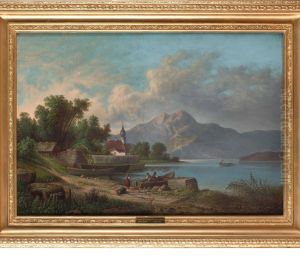Fredrik Bernhard Blombergsson Paintings
Fredrik Bernhard Blombergsson was a Swedish artist, born in 1802, whose work has been recognized for its contribution to the early 19th-century European art scene. Although not as widely known as some of his contemporaries, Blombergsson's paintings and sketches offer a unique glimpse into the cultural and societal landscapes of his time. His life and career were marked by a deep commitment to capturing the essence of his homeland’s natural beauty and the everyday lives of its people.
Blombergsson was born into a modest family in the countryside of Sweden, where the natural landscapes deeply influenced his artistic vision from an early age. He pursued his art education at the Royal Swedish Academy of Fine Arts, where he developed a keen interest in landscape painting and portraiture. His early work is characterized by meticulous attention to detail and a profound appreciation for the interplay of light and shadow, which became hallmarks of his style.
Throughout his career, Blombergsson traveled extensively across Sweden, often on foot, to capture the country's diverse regions and communities. His paintings from this period not only reflect the beauty of the Swedish landscape but also serve as historical documents of rural life in the 19th century. Blombergsson's commitment to realism and his ability to evoke emotion and atmosphere in his work garnered him recognition among his peers and art enthusiasts alike.
Despite his contributions to Swedish art and culture, Blombergsson's work was not widely celebrated during his lifetime. It was only after his death in 1853 that his paintings gained broader recognition. Today, his works are considered important pieces of Swedish cultural heritage and can be found in museums and private collections across the country. Blombergsson's legacy lives on as an artist who captured the soul of Sweden through his dedication to realism, his love for his homeland, and his exceptional ability to depict the natural and human landscapes of his time.
